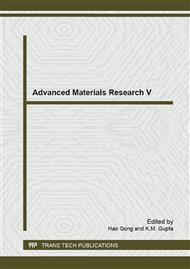p.74
p.78
p.83
p.88
p.93
p.99
p.105
p.110
p.117
Effect of Cutting Parameters on the Quality of the Machined Surface of Cu-Zn-Al Shape Memory Alloy, SMA
Abstract:
Shape memory alloys (SMAs) are now widely used in many industrial and engineering applications e.g. in aircrafts, space vehicles, robotics and actuators. However the available literature reveals that little or no work is published on the machinability of these alloys. In this paper, the effect of the main cutting parameters namely: cutting speed, depth of cut and feed rate on the surface quality of the machined surface of the Cu-Zn-Al shape memory alloy both in the cast and after direct extrusion using a CNC milling is investigated. The cutting speed was varied from 750 to 2000 rpm , the depth of cut was varied from 1 to 4 mm and the feed rate was varied from 100 to 250 mm/min. Furthermore, the general microstructure, the mechanical behavior and hardness of the Cu-Zn-Al shape memory alloy both in the cast and after direct extrusion are determined and discussed. It was found that the best achieved surface quality in this SMA, machined within the different investigated cutting conditions is 0.13 microns at cutting speed of 750 rpm, 1 mm depth of cut and 150 mm/min. feed rate, which is better than the surface quality achieved in other materials at the same cutting conditions.
Info:
Periodical:
Pages:
93-98
Citation:
Online since:
May 2015
Authors:
Keywords:
Price:
Сopyright:
© 2015 Trans Tech Publications Ltd. All Rights Reserved
Share:
Citation:


